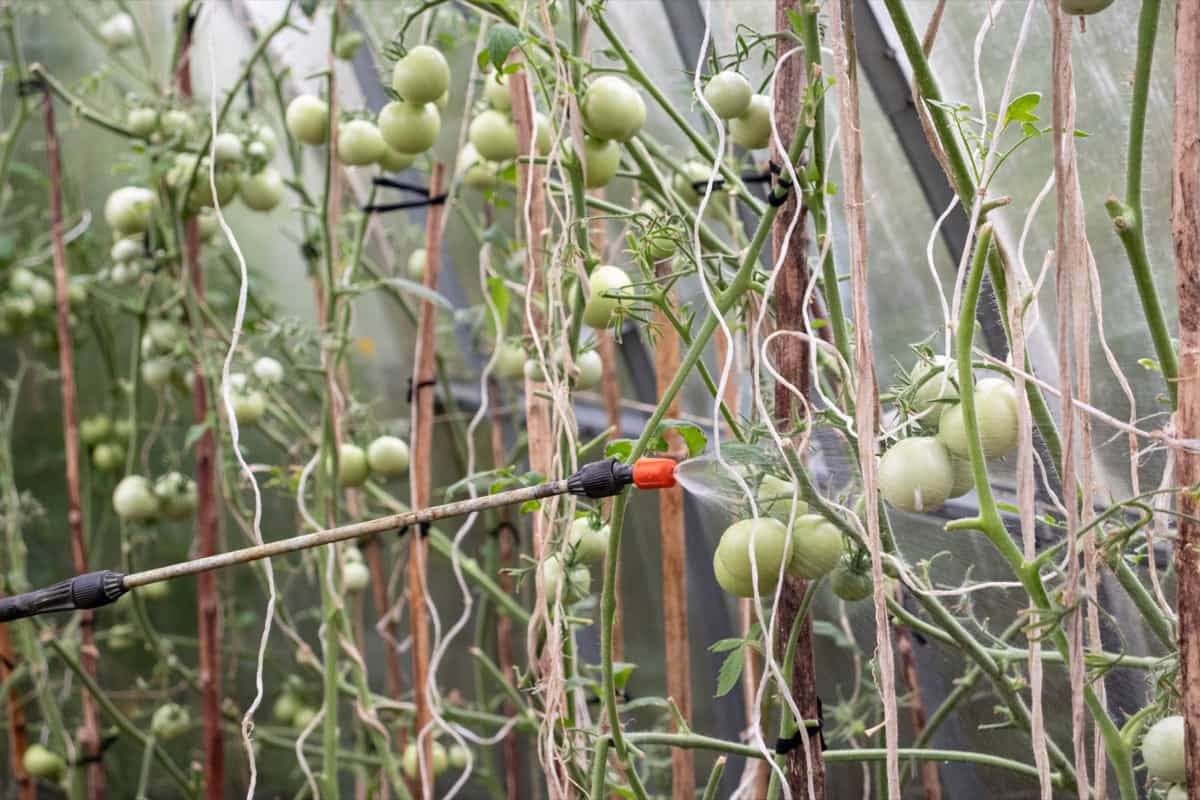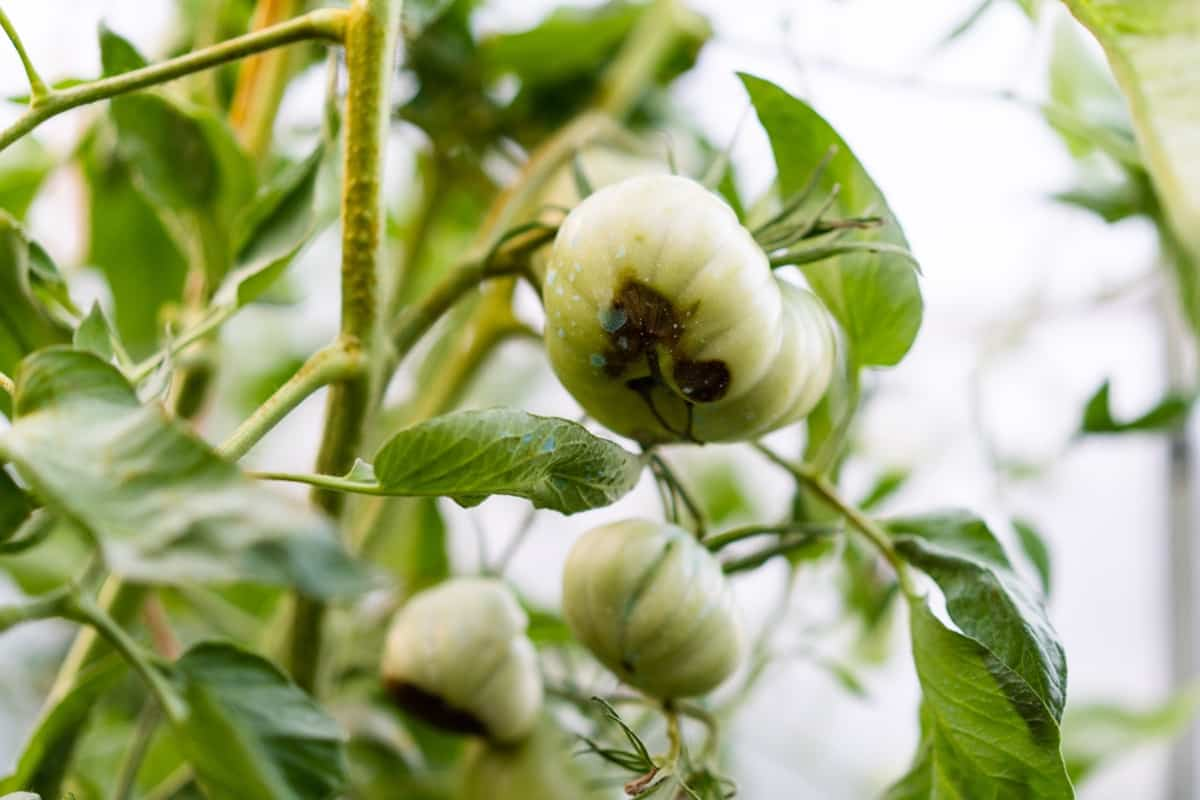Step into the fascinating world of tomato plants and their battle against damaging diseases! Tomatoes, beloved by gardeners and food enthusiasts alike, are vulnerable to a range of diseases that can jeopardize their quality and yield. Tomatoes, one of the most popular and widely cultivated vegetables, face several damaging diseases that can significantly impact their growth and productivity.
In this comprehensive guide, we will explore the major diseases affecting tomatoes, their symptoms, methods of identification, disease cycles, treatment options, and effective management strategies.

How to Treat Tomato Damaging Diseases
Major and Common Damaging Diseases in Tomato
- Damping Off: Damping off is a common disease in tomato seedlings caused by fungal pathogens. It leads to the decay of the stem and roots, resulting in wilting and death of the young plants.
- Septoria Leaf Spot: Septoria leaf spot is a damaging disease characterized by brown spots with dark borders on the leaves. It is caused by the fungal pathogen Septoria lycopersici and can lead to defoliation and reduced tomato yield.
- Bacterial Stem and Fruit Canker: This disease is caused by bacterial pathogens, such as Clavibacter michiganensis. It affects the stems and fruits, causing dark, sunken lesions. It can result in yield loss and poor fruit quality.
- Early Blight: The fungus Alternaria solani causes early blight, which affects tomato leaves, stems, and fruits. It leads to the formation of dark concentric rings on the leaves, eventually causing defoliation and reduced fruit production.
- Bacterial Leaf Spot: Bacterial leaf spot is caused by Xanthomonas species. It causes small, water-soaked lesions on the leaves, which later turn into brown spots with yellow halos. Severe infections can lead to defoliation and reduced fruit quality.
- Bacterial Wilt: Bacterial wilt, caused by Ralstonia solanacearum, is a devastating disease affecting tomato plants’ vascular system. It leads to wilting, yellowing of leaves, and eventual death of the plant. It can cause significant yield losses.
- Leaf Curl: Leaf curl is a viral disease that causes curling and distortion of tomato leaves. Whiteflies primarily transmit it. Infected plants show stunted growth, leaf curling, and reduced fruit production.
- Mosaic: Tomato mosaic virus causes mosaic patterns on tomato leaves, with light and dark green areas. It can result in stunted growth, leaf distortion, and reduced yield. The virus can be mechanically transmitted through contaminated tools or by infected plants.
- Tomato Spotted Wilt Disease: The Tomato Spotted Wilt Virus is the cause of tomato-spotted wilt disease. It affects various parts of the plant, causing necrotic spots, wilting, and deformation of fruits. It can lead to significant crop losses.
- Fusarium Wilt: Fusarium wilt, caused by the soil-borne fungus Fusarium oxysporum, affects the vascular system of tomato plants. It causes wilting and yellowing of leaves and can lead to plant death. It is a major concern for tomato growers worldwide.
Damping Off Signs and Damage Symptoms in Tomato
Damping off disease in tomatoes occurs in two stages: pre-emergence and post-emergence. Pre-emergence damping off leads to the death of seedlings just before they reach the soil surface, resulting in complete rotting. Post-emergence damping off infects the young tissues at the ground level, causing softening and collapse of the affected seedlings.
Favorable conditions for damping off include high humidity, excessive soil moisture, cloudiness, and low temperatures below 24°C for an extended period. Crowded seedlings, poor drainage, and excessive soil solutes also contribute to the spread of this disease. Avoid excessive watering and poorly drained areas in the field. Use raised beds or pro-trays for raising seedlings. Treat seeds with Trichoderma viride or captan for biological and chemical control.
Septoria Leaf Spot Control and Management in Tomato
Septoria leaf spot affects tomato plants, primarily targeting less vigorous ones. The disease manifests as small, round, to irregular spots on the leaves, with a gray center and a dark margin. These spots typically start on the lower leaves and gradually progress upwards, eventually causing blight and complete defoliation. In some cases, stems and flowers may also be affected, although fruit damage is rare.
The survival and spread of the Septoria leaf spot occur through mycelium or conidia present in pycnidia on infected plant debris or solanaceous weeds. Rain splash, wind, and physical contact with contaminated hands or clothing of tomato pickers also contribute to its transmission. The disease thrives under poor plant vigor, high humidity, and intermittent showers. Remove and destroy affected plant parts. Apply mancozeb for chemical control.
Bacterial Stem and Fruit Canker Prevention and Treatment in Tomato
Bacterial stem and fruit canker disease is characterized by the appearance of spots on leaves, stems, and fruits, as well as wilting of leaves and shoots. Initially, white blister-like spots develop on the leaf margins, which turn brown with age and eventually merge. Infected stems and petioles exhibit light-colored streaks at the joints, which crack and form cankers. The disease also causes small, shallow, water-soaked spots on the fruits, with raised tan-colored centers.
Splitting open the stems reveals vascular discoloration. The primary sources of survival and spread for bacterial stem and fruit canker are infected plant debris and seeds, internally and externally, and solanaceous weeds like Solanum nigrum. Rain splash aids in the transmission of bacterial cells. The disease thrives under soil temperatures around 28°C, high humidity or persistent dew, and moist weather with intermittent showers.
Early Blight Disease Management in Tomato
Early blight is a common disease affecting tomatoes throughout their growth stages. It is characterized by small, black lesions that first appear on the older foliage of plants. As the disease progresses, these lesions enlarge and develop concentric rings, leading to tissue yellowing and substantial foliar death under high-temperature and humidity conditions. Stems may also be affected, potentially causing girdling near the soil line.
In case you missed it: Early Blight Management in Tomato: Symptoms, Treatment, Chemical, Biological, Natural, and Organic Control

Late blight fungus infection can lead to plant death and infect the fruit through the calyx or stem attachment, resulting in lesions and concentric rings. Survival and spread of early blight occur through the winter survival of the fungus in infected plant debris in the soil, seed transmission, and transport of spores by water, wind, insects, animals, and machinery.
Warm, rainy, and wet weather conditions favor its development. Use resistant cultivars, change nursery bed location, and avoid overlapping crops. Apply azoxystrobin, captan, or copper-based fungicides for chemical control.
Bacterial Leaf Spot Disease Management in Tomato
Moist weather and splattering rains create favorable conditions for developing bacterial leaf spots. Infected leaves exhibit small, brown, water-soaked circular spots surrounded by a yellowish halo. Older leaves, especially on mature plants, are predominantly affected, which can result in significant defoliation.
The disease also affects green fruit, causing small, water-soaked spots that grow, become raised, and develop a rough, scabby surface. Ripe fruits, however, are not susceptible to the disease. Bacterial cells survive on infected plant debris, internally and externally on seeds, and solanaceous weeds such as Solanum nigrum. Rain splash aids in the transmission of bacterial cells. Spray streptomycin sulfate and tetracycline hydrochloride solution for chemical control.
Bacterial Wilt Prevention and Treatment in Tomato
The rapid and complete wilting of fully-grown tomato plants characterizes bacterial wilt. Lower leaves may drop before wilting, and upon cutting infected plant parts and immersing them in clear water, a white streak of bacterial ooze becomes visible. The pathogen primarily affects the vascular region, occasionally invading the cortex and pith, leading to yellow-brown discoloration.
Bacterial wilt spreads through wounds, soil, and contaminated implements. Relatively high soil moisture promotes its development. Practice crop rotations, use pathogen-free seedlings, and restrict the flow of irrigation water from affected fields. Apply neem cake for biological control.
Leaf Curl Disease Management in Tomato
Leaf curl disease is evident through severe stunting of tomato plants, with leaves showing a downward rolling and crinkling pattern. Newly emerging leaves exhibit a slight yellow coloration, progressing to curling symptoms. Older leaves become leathery and brittle, and the nodes and internodes are noticeably reduced in size. Infected plants often appear pale and produce more lateral branches, resulting in a bushy appearance. Whiteflies act as vectors for transmitting the leaf curl virus. Raise the nursery in protected conditions, select disease-free seeds, and use imidacloprid for root dip treatment.
Mosaic Disease Management in Tomato
The mosaic disease is characterized by light and dark green mottling on the leaves, accompanied by wilting of young leaves when exposed to direct sunlight. Affected leaflets are usually distorted, puckered, and smaller than normal, often displaying “fern leaf” symptoms. Infected plants appear stunted, pale green, and spindly. The virus responsible for mosaic disease spreads through contact with contaminated clothing, hands, infected plants, plant debris, and implements.
Tomato Spotted Wilt Disease Control
Symptoms of Tomato spotted wilt disease vary among host plants, but stunting is common. Infected hosts exhibit chlorotic or necrotic rings on their leaves, along with thickened veins and bronzing of young leaves. Growing tips may die back, terminal branches display streaks, and affected plants may exhibit wilting or a one-sided growth habit.Ripe tomatoes may develop pale red or yellow areas with concentric circular markings, and the seeds can become discolored. The virus survives in infected plants of various hosts, while thrips act as vectors for its transmission.
Fusarium Wilt Prevention and Treatment in Tomato
Fusarium wilt initially presents as the clearing of veinlets and chlorosis of leaves. Younger leaves may progressively die, resulting in wilting and death of the entire plant within a few days. Petioles and leaves droop and wilt; lower leaves display yellowing in the field before affected leaflets wilt and perish.
Browning of the vascular system occurs at later stages, leading to stunted growth and plant death. The disease persists in soil and can spread through contaminated implements. Relatively high soil moisture and temperature contribute to its development. Treat seeds with Trichoderma viride and apply it to the field after sowing/transplanting.
In case you missed it: Bacterial Canker Management in Tomato: Symptoms, Treatment, Chemical, Biological, Natural, and Organic Control

Conclusion
Common chilli insect diseases can cause significant damage to plants. Early identification of symptoms, understanding the disease cycle, and implementing appropriate treatment and management strategies are crucial for effectively controlling and protecting chilli crops.
- Deworming Schedule for Dogs/Puppies: A Beginners Guide
- How to Prevent and Control Parasites in Goats
- Beneficial Insects in Pest Management
- Natural Solutions for Pest Control in Flower Gardens
- Types of Fungicides Used in Agriculture
- Common Issues in the Fruit Development Stage of Pomegranate Farming
- Fruit Development Issues in Papaya: Easy Solutions and Treatment
- Soil-Borne Diseases and How to Protect Your Plants
- Practices to Prevent Disease Spread in the Garden